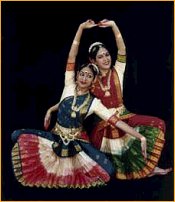 |
 |
'Divine' Dances Tie Ancient
Past With Present
November, 2001
|
 |
| The
Norton Simon Museum in Pasadena California is known as a host of one of
the largest collections of South Asian Art in the United States.
When the museum, for the first timed in its renowned history, decided to
present an evening of dances as part of their Friday night series, they
approached renowned dancer/choreographer and commissioned her to make this
breakthrough presentation. After studying the collections closely,
Ramaa designed a 40-minute presentation, "DARSAN - Dances of the Divine".
Presented on Friday September 28th, to a completely sold-out audience,
the program
depicted three of the Chola images from the exhibit by bringing them to life through movement. "The bronzes
tell a story - they are movement captured in time, mythology in a frozen
state. The purpose of my performance was to bring out, through the dancing
body, the stories, the texture, color, dimension and movement that are
inherent in these frozen masterpieces. My choreography
The following is a review of the performance as it appeared in the Los Angeles Times. |
| Times
like these sometimes call for dances of cosmic proportions.
Ramaa Bharadvaj's program Friday at the Norton Simon Museum would under any circumstances have inspired awe, but it did the more so because aesthetic connection between classical Indian dance and current events was not avoided. She encouraged her audience for "Darsan--Dances of the Divine" to visit the Norton Simon's stunning, permanent collection of Chola bronzes before the performance, making us aware that her three new works had been inspired by images of the deities Ganesa, Krishna and Siva. Squashing dwarves beneath their feet, swinging their raised legs across their bodies in dynamic defiance, the 10th century figures of Siva as Nataraja--master dancer of the universe--let you know that the cycle of destruction, preservation, and creation is indeed endless. These bronzes are old. The dances and stories they depict are even older. After audience members returned upstairs to the Norton Simon Museum Theater, Bharadvaj asked them to consider the stage sacred. (This was the first time the Norton Simon had used it for dance, and the sightlines and amplitude of the intimate theater are ideal.) She gave it her apt blessing with "Invocation to Ganesa," strewing imaginary petals before the path of the lumbering, elephant-headed god, danced by Swetha Bharadvaj. But it was the "Dance of Krishna" and the concluding, "Palli Ezhuchchi--The Awakening," both in the Bharatanatyam style, that really charged the place. In "Krishna," Bharadvaj's student, an impressive 9-year-old prodigy, Medha Raj, teased excitement out of the air with a victory dance over the collapsed body of Swetha Bharadvaj as a polluting river demon. In the vision of this confident child, Bharadvaj wanted us to see hope, alluding to the present national crisis in her program notes--and we did. And in "The Awakening," a solo for an arrestingly expressive Swetha as Siva Nataraja, we felt the full metaphoric impact of history's relentless creation-and-destruction cycle, as she swung her leg across her body and ended in the exact pose of the Chola bronze seen earlier. Remarks by
esteemed Asian art scholar Pratapaditya Pal and the lighting design of
Chris Flores enhanced the one-night-only program.
Reproduced
with permission from Sasha Anawalt
|